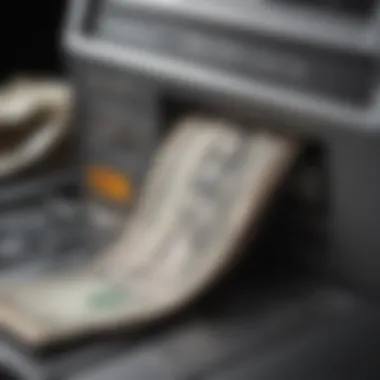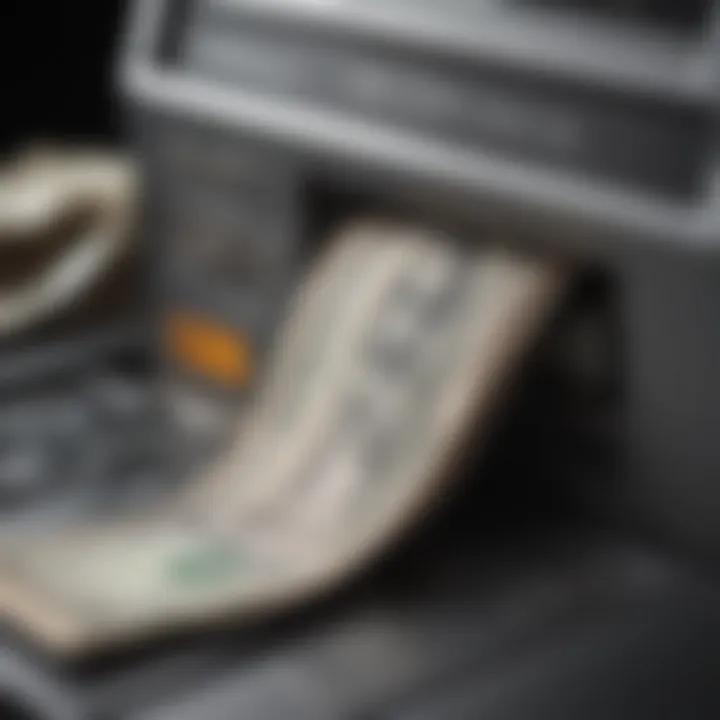Withdrawing Cash from Your Discover Card: A Guide


Intro
Accessing cash from a credit card can feel complex. Yet, it is a crucial resource for many. This article aims to clarify the process of withdrawing cash from a Discover Card. It will delve into specific details that can help users make better financial decisions. The guide focuses on understanding fees, alternatives, and practical advice that enhances the overall experience of cash withdrawals.
Overview of Financial Product
Definition of product
A Discover Card is a type of credit card issued by Discover Financial Services. It offers various features like rewards, cash back, and of course, cash advances. A cash advance allows cardholders to withdraw cash directly, providing liquidity when needed.
Importance of the product for consumers
Cash withdrawals via credit cards can be critical, especially in emergencies. Consumers want quick access to funds without dealing with traditional bank services. Understanding this product is essential for managing personal finances effectively. Access to cash can provide flexibility in unexpected situations.
Types of available options
Discover offers various types of credit cards. These can be used for cash advances. Common options include the Discover it® Cash Back card and Discover it® Miles. Both cards allow cash withdrawals but come with different terms and conditions. Knowing these differences is essential before making any decisions.
In-Depth Comparison
Feature analysis
Discover cards offer many features. Cash advances are typically straightforward but have specific terms. Points such as withdrawal limits and fees are critical. Some cards may provide higher cash limits compared to others.
Benefits vs.
drawbacks
Cash advances provide quick access to money, a significant benefit in emergencies. On the downside, these withdrawals often incur fees. Interest rates for cash advances are generally higher than regular purchases too. This is a vital consideration for consumers.
Cost considerations
When using a Discover Card for cash advances, consumers should be aware of the costs involved. A transaction fee usually applies, often around 5% of the amount withdrawn. Also, interest begins to accrue immediately, which can add to the total cost over time.
User ratings and reviews
User experiences vary. Many praise Discover’s customer service and user-friendly interface. However, some users express dissatisfaction over the high fees associated with cash advances. Checking reviews online, such as on Reddit, may provide insights.
Best Practices for Choosing the Right Product
Key factors to consider
When selecting a credit card for cash withdrawal, consider fees, interest rates, and rewards programs. Evaluate how often you may need to access cash through the card.
Tips for evaluating different options
Review multiple Discover card options. Compare fees, interest rates, and withdrawal limits. This step ensures you select a card that will serve your financial needs effectively.
Importance of researching providers
Researching providers like Discover is crucial. Understanding their policies and user experiences can help you make informed decisions. Visit platforms such as Facebook for community insights or en.wikipedia.org for detailed credit card information.
Application Process
Step-by-step guide for applying
- Go to the Discover website.
- Choose the card that meets your needs.
- Fill in the application form with the required details.
- Submit the application and await confirmation.
Required documentation and eligibility
Documentation may include identification, income proofs, and previous credit history. Ensure you meet eligibility criteria before applying.
Common pitfalls to avoid
Avoid applying for multiple cards at once. This may negatively affect your credit score. Additionally, understand the terms before making any withdrawals to avoid surprises.
Timeline expectations for approval
Approval times can vary. Some applications might receive instant approvals, while others may take a few days for verification.
Ongoing Management and Strategy
Tips for monitoring and managing the product
Regularly check your account statements. This helps track cash withdrawals and understand fees associated with them. Use the Discover app for real-time insights.
Strategies for maximizing benefits


Consider paying off any cash advance as soon as possible. This will minimize interest fees. Also, explore rewards programs that can offset some of the costs.
When to re-evaluate or switch products
If high fees persist, it may be time to reassess your card choice. Explore other financial products that offer lower fees or better terms for cash withdrawals.
Resources for staying updated with market trends
Stay informed by following financial news on platforms like britannica.com or financial blogs. Knowledge is vital in making sound decisions about credit products.
Knowing what you are getting into with cash withdrawals can save you from financial troubles in the future.
Understanding Cash Advances
Withdrawing cash using a credit card can be a useful but often misunderstood aspect of credit card usage, particularly for those who hold a Discover Card. Understanding cash advances is crucial for anyone seeking to utilize their card for more than just purchases. The primary advantage of cash advances is the immediate access to funds without the lengthy process associated with traditional loans. However, potential drawbacks include high fees and steep interest rates, which are vital to grasp.
In this section, we will delve into what a cash advance is, the different types available, and the implications they carry for your financial health. This foundational knowledge is imperative, as it sets the stage for deeper insights into how to responsibly withdraw cash from your Discover Card.
Definition of a Cash Advance
A cash advance refers to the ability to withdraw cash using your credit card. Unlike making a standard purchase, cash advances allow cardholders to obtain cash either through an ATM or a bank, effectively converting their available credit limit into immediate spendable cash. During this transaction, the amount withdrawn is then added to the cardholder's credit balance.
This type of cash withdrawal can be beneficial during emergencies or situations where immediate cash is necessary and traditional banking methods are not feasible. However, cash advances typically come with their terms, including a cash advance fee, which can be as high as 5%, and potentially higher interest rates that start accumulating right from the withdrawal date. Unlike standard purchases, which usually have a grace period, cash advances do not, which significantly affects the total amount repayable.
Types of Cash Advances
When it comes to cash advances, there are different ways to execute this financial maneuver. It's useful to understand these options to better select the method that suits your circumstances. Below are some commonly used types of cash advances:
- ATM Cash Advances: One of the most prevalent ways to withdraw cash from a credit card. Users can access ATMs that accept Discover, provided they have a personal identification number (PIN).
- Bank Withdrawals: A more traditional method involves going to a bank or credit union. Cardholders can withdraw cash directly by showing their Discover card and identification.
- Convenience Checks: Some credit card issuers provide convenience checks that can be used like standard checks but draw from your credit line. Cashing these checks is another way to obtain cash.
- Cash Transfers: Some cardholders use cash advances to transfer funds to a bank account. This method is less common but possible in certain scenarios.
Understanding the various types of cash advances enables better financial planning and can prevent costly mistakes. It also prepares you for potential fees and expenses that may arise from each method, ensuring a more informed decision-making process when accessing cash from your Discover Card.
Discover Card Overview
The Discover Card is a well-recognized financial tool throughout the United States. Understanding its overview is crucial when considering cash withdrawals or any financial transactions. The features and benefits that come with a Discover Card play a significant role in enhancing the user experience. Additionally, an awareness of the interest rates and fees associated with the card can lead to more informed financial decisions. By appreciating these aspects, users can maximize their card’s potential while minimizing their out-of-pocket costs.
Card Features and Benefits
Discover Card offers several features that cater to a variety of users. One distinctive aspect is the cashback rewards program. Users earn a percentage of cash back on various purchases, which makes the card enticing for regular shoppers. Moreover, Discover has no annual fee, allowing consumers to use the card without extra charges just for having it.
Other notable features include:
- No foreign transaction fees: This allows for easier international use, making it a suitable option for travelers.
- Access to credit scores: Cardholders can monitor their credit scores regularly through the Discover platform, enhancing financial awareness.
- Fraud protection: Discover provides robust fraud protection systems, ensuring that unauthorized transactions are not a risk for users.
Having a clear picture of these benefits can help individuals make informed decisions about using their credit cards effectively.
Interest Rates and Fees
When it comes to credit cards, interest rates and fees are critical factors that affect overall cost. The interest rates on a Discover Card can vary based on creditworthiness, but they are typically competitive within the market. It is important to review the annual percentage rate (APR) applicable to cash advances, as this rate is often higher than for regular purchases.
Besides interest rates, there are specific fees to consider:
- Cash advance fees: These can be a percentage of the cash amount withdrawn or a flat rate, whichever is greater.
- ATM fees: Using non-Discover ATMs may incur additional charges, adding to the overall cost of withdrawals.
- Foreign transaction fees: Though Discover cards typically do not have these fees, it is important to check before traveling.
Knowing how these fees and rates intertwine can help users avoid unexpected costs and ensure that they are managing their finances wisely.
How to Withdraw Cash from Your Discover Card
Withdrawing cash from your Discover Card can be essential for accessing funds rapidly. Understanding how to do this is vital because it can influence your overall financial strategy. This section delves into the practical steps of cash withdrawal and explores the approach through ATMs and bank visits. Knowing the processes involved can lead to better financial management as you navigate the intricacies of your Discover Card.
ATM Withdrawals
Finding Compatible ATMs
Finding compatible ATMs is a crucial step when considering cash withdrawals with your Discover Card. Most often, Discover has partnerships with various ATM networks, allowing you to avoid excessive fees. Typically, this means you can access your money conveniently without incurring high charges.
A key characteristic of locating compatible ATMs is convenience. Many ATMs are accessible 24/7, providing flexibility for your cash needs. Additionally, using an ATM within the network can save you from surcharges that some banks impose for cash transactions.
However, there are unique aspects to consider when finding ATMs. You need to ensure that the ATM not only accepts Discover Cards but also aligns with your local needs. Some networks may not be available in certain areas, limiting options in more rural regions. Therefore, verifying compatibility before heading to an ATM is important.
Process of Withdrawing Cash
Understanding the process of withdrawing cash from an ATM is straightforward yet requires attention to detail to make the experience efficient. After locating a compatible ATM, you would begin by inserting your Discover Card and entering your PIN. The next steps are to select the withdrawal option, choose the cash amount, and confirm the transaction.
The key characteristic here is speed. ATM withdrawals are typically swift, allowing you to receive cash almost immediately. The ease of access means you can resolve urgent financial needs quickly. One unique feature of this process is that you can usually alter your withdrawal limits based on the ATM's policies.
Despite its advantages, there are disadvantages. For example, many ATMs have maximum withdrawal limits that can restrict the amount of cash you can obtain at one time. Furthermore, ATM outages or maintenance can affect your ability to withdraw cash when needed.


Bank Withdrawal Process
Requirements for Bank Withdrawal
When opting to withdraw cash at a bank, it is essential to understand the requirements. To initiate this kind of transaction, typically, you must present your Discover Card and a government-issued ID. Some banks may have additional requirements, such as account verification or prior alerts of your visit.
A key characteristic is accessibility, as not all banks are equipped to process Discover Card transactions. However, if successful, this method can help extract larger sums of cash, particularly beneficial for significant purchases or needs.
There’s a unique feature to consider here, which is customer service. Depending on the bank you choose, you may receive assistance with the withdrawal process. This can be helpful if you face any complications. However, the downside can be the wait time, particularly if the bank is busy.
Steps Involved
The steps involved in withdrawing cash from a bank using your Discover Card are fairly systematic. Start by gathering the required documents and then proceed to the bank. Approaching a teller, present your card and identification. After they verify your identity, you will specify the amount of cash you wish to withdraw.
The key characteristic of this process is the personal service provided. Unlike ATMs, bank tellers can assist with any questions or issues regarding the withdrawal. This may add a layer of security to your transaction that ATM withdrawals lack.
However, the steps involved may vary by institution. Not all banks have the same policies, which could result in differing wait times and requirements. Additionally, bank hours might limit your ability to withdraw cash outside of standard business hours.
Fees Associated with Cash Withdrawals
Understanding the fees related to cash withdrawals is a crucial part of navigating the financial landscape of using a Discover Card. Each withdrawal can come with its own set of costs, which can quickly add up if one is not careful. Recognizing these fees helps users make informed decisions and avoid unnecessary expenses. Knowing the potential costs involved also aids in budgeting and ensures that using a credit card for cash access remains a practical option in times of need.
Cash Advance Fees
A significant fee consumers face when withdrawing cash from their Discover Card is the cash advance fee. This fee is typically defined as a percentage of the amount withdrawn, with a minimum charge involved.
- Typical cash advance fees range from 3% to 5% of the total withdrawal. It is essential to refer to your specific card terms for exact percentages.
- This fee is applied to each cash advance made, which means withdrawing cash multiple times can lead to noticeable costs.
Moreover, cash advances often incur different interest rates than regular purchases. Consequently, individuals may find themselves incurring additional charges if the balance is not paid off timely. Understanding these fees ensures that one considers alternative options or strategic planning, which ultimately saves money.
ATM Fees
When using an ATM to withdraw cash from a Discover Card, it is vital to consider ATM fees in addition to the cash advance fee. These fees can vary significantly based on the ATM operator and may not be waived.
- Fees might include:
- Network fees imposed by the ATM owner.
- Currency conversion fees for international transactions.
Using ATMs outside of the Discover network can result in the highest fees. Therefore, seeking compatible ATMs can reduce costs effectively. A cardholder should have access to a list of ATMs that do not charge additional fees. Always check for the listed fee at the ATM before completing the withdrawal to avoid surprises on your statement.
Foreign Transaction Fees
Another fee that may come into play is the foreign transaction fee, which is important for those who travel internationally or transact in foreign currencies. This fee is usually assessed on transactions processed outside the United States and is often a percentage of the transaction amount.
- Typical foreign transaction fees amount to around 1% to 3% of the purchase or withdrawal.
- It is important to note that this fee applies not only to withdrawing cash from ATMs internationally but also to purchases made in foreign currencies.
Travelers using their Discover Card overseas should be especially mindful of these fees. Assessing the total costs, including foreign transaction fees, can help in determining whether to use a credit card for cash access abroad or seek other methods such as local currency exchange.
Understanding excessive fees can enable individuals to manage their finances more effectively. Awareness leads to better decision-making when considering cash advances.
In summary, being informed about the various fees associated with cash withdrawals from a Discover Card can significantly influence financial planning and decision-making. It is essential to consider these factors to maintain healthy finances and avoid unexpected charges.
Impact on Credit Utilization and Score
The notion of credit utilization is crucial when considering cash withdrawals from a Discover Card. This section dives into how utilizing funds through cash advances impacts one's overall credit profile. Understanding these effects helps consumers make informed financial decisions. Notably, how much of your available credit you use plays a significant role in your credit score calculation.
Understanding Credit Utilization
Credit utilization is the ratio of your credit card balances to your credit limits. It reflects how much of your available credit you are using at any given time. Generally, a lower credit utilization ratio is favorable. It suggests responsible credit management. It's often recommended to keep this ratio below 30%. When you withdraw cash from your Discover Card, it counts against your overall credit limit.
Therefore, if you were to withdraw a sizable amount, it could significantly increase your utilization rate. For example, if your credit limit is $5,000 and you withdraw $1,000, your utilization instantly jumps to 20%. Continuous high utilization could indicate to lenders that you are overly reliant on credit, which might negatively influence their perception of your creditworthiness.
Consequences of High Utilization
Exceeding recommended credit utilization thresholds can lead to several negative consequences. When utilization remains elevated, it can signal risk to creditors. This situation can result in increased interest rates, lower credit limits, or even difficulty obtaining new credit.
A credit utilization ratio higher than 30% can negatively impact your credit score, making it essential to monitor your spending.
In summary, being aware of your credit utilization is essential for maintaining a healthy credit score. This understanding equips consumers with the knowledge to navigate the potential pitfalls associated with cash advances effectively. Regularly assessing your utilization will help you avoid unnecessary financial complications while managing your credit responsibly.
Alternatives to Cash Advances
Considering cash advances from a credit card can be tempting in times of urgency. However, it's crucial to recognize that alternatives may better suit your financial needs. This section explores various options that can help you access cash without the high fees or interest rates often associated with cash advances. Understanding these alternatives will empower you to make informed decisions and possibly save money in the process.
Using Debit Cards
Debit cards represent a practical alternative to cash advances. Unlike credit cards, a debit card draws money directly from a checking account. This ensures that you are spending only what you have, minimizing the risks of debt accumulation. When you use a debit card, you evade fees associated with cash advances.


Benefits of Debit Cards:
- Immediate Access to Funds: You can withdraw cash easily from ATMs or make purchases directly.
- No Interest Charges: Since you are using your own money, there are no interest charges like those found with cash advances.
- Budget Control: Using a debit card helps you maintain better control over your spending.
Though debit cards are not widely associated with cash advances, they remain a viable means of accessing funds without incurring a debt burden.
Personal Loans
Personal loans stand out as another alternative for those in need of cash. These loans are typically issued by banks or credit unions and can provide larger amounts than cash advances. Personal loans also come with a fixed repayment schedule, making them easier to manage than an unpredictable interest rate on cash advances.
Key Considerations:
- Lower Interest Rates: Compared to cash advances, personal loans tend to have lower interest rates.
- Flexible Amounts: You can often borrow a sum that meets your exact needs.
- Structured Repayment: You have a clear timeline for paying back the loan.
Before opting for a personal loan, consider your repayment capacity, as failure to pay on time can damage your credit score.
Peer-to-Peer Lending
Peer-to-peer lending platforms have risen in popularity as an alternative source of financing. These platforms connect borrowers directly with investors, bypassing traditional banking institutions. This method can often lead to lower interest rates and more favorable loan terms than cash advances.
Advantages of Peer-to-Peer Lending:
- Competitive Rates: Due to the nature of the marketplace, rates can be more appealing.
- Quick Access to Funds: The process can be quicker than dealing with formal banks, providing cash in times of need.
- Flexible Terms: Lenders might offer customized repayment plans.
Before committing, evaluate the interest rates and terms offered by different platforms to ensure you select a fit that meets your needs.
In summary, understanding alternatives to cash advances can save you money and stress. Each option offers unique benefits that should be weighed carefully against your circumstances. Keep in mind that financial health should always be a priority, and exploring these alternatives puts you in a position of power.
Best Practices for Using Cash Advances
Withdrawing cash from a credit card, like the Discover Card, can serve a purpose in certain financial scenarios. However, it can also lead to challenges if approached without caution. To mitigate potential downsides, it's essential to adhere to best practices while utilizing cash advances. These practices help in making informed decisions that align with your financial health and avoid traps that can lead to debt accumulation. Here are some key elements to consider:
- Minimize Withdrawal Frequency: Frequent cash advances can quickly lead to high fees and increased interest rates. It’s advisable to limit these transactions to urgent situations only.
- Set a Budget: Always have a clear budget in mind when planning for a cash advance. Know how much you need and, more critically, how you intend to pay it back.
- Explore Alternatives: Before opting for a cash advance, consider other options like debit card use or even personal loans. They may offer better terms.
Planning and knowledge are the first steps in avoiding financial pitfalls.
Being aware of these best practices equips users with the tools needed to navigate cash advances effectively. Understanding the implications of decisions made today on future financial health is vital.
Planning Ahead
Planning ahead is crucial when considering a cash advance. This involves assessing your need for funds carefully, making a pre-defined strategy on how to utilize the cash, and establishing a clear repayment plan. Here are some practical aspects of planning:
- Assess Your Immediate Needs: Make sure that the cash advance is genuinely necessary. Evaluate your current financial situation to determine if there are alternative solutions, such as using savings or budgeting adjustments.
- Calculate Potential Costs: Understand the fees associated with your cash withdrawal. These include cash advance fees, interest rates, and potential ATM fees. It is important to know the total cost before proceeding.
- Establish a Repayment Date: This will aid in avoiding accruing substantial interest. Having a specific timeframe can motivate you to prioritize repayment.
When planning ahead, you take control of your financial journey. Setting clear objectives can help to establish a solid financial foundation.
Understanding Terms and Conditions
Another fundamental best practice is to fully understand the terms and conditions of your Discover Card, particularly regarding cash advances. Many cardholders may neglect this aspect, leading to avoidable challenges. Here’s what to focus on:
- Interest Rates: Cash advances often incur higher interest rates than regular purchases. Familiarizing yourself with these rates can help in assessing the financial implications of withdrawing cash from your card.
- Fees: Cash advance fees can vary by transaction. Knowing these can prevent unexpected costs when you need cash urgently.
- Grace Periods: Typically, cash advances do not come with a grace period, which means interest starts accruing immediately. Awareness of this can alter your approach if you require immediate cash but don’t have a project for repayment.
Being informed about conditions allows for clearer decision-making. Rather than facing penalties due to ignorance, taking the time to understand your card’s stipulations ensures that you use cash advances wisely.
Common Mistakes to Avoid
When withdrawing cash from your Discover Card, some errors can quickly lead to unexpected consequences. Understanding these mistakes is crucial for efficient financial management. This section outlines common pitfalls and offers guidance on how to avoid them.
Underestimating Fees
One of the frequent errors individuals make is underestimating the fees associated with cash withdrawals. Cash advances often come with specific costs that are not immediately apparent. For example, the cash advance fee is typically a percentage of the amount withdrawn or a fixed dollar amount, whichever is higher. Additionally, ATM operators may impose their own fees, further inflating the total cost.
Key considerations include:
- Reviewing your credit card’s terms regarding cash advance fees.
- Calculating the total cost before proceeding with a withdrawal.
- Understanding that fees could accumulate if the balance is not paid quickly.
It is vital to read the fine print and be fully aware of these expenses. By doing so, you can prevent financial surprises that could affect your budgeting.
Ignoring Interest Rates
Another common mistake is ignoring the interest rates tied to cash advances. Cash advances often carry higher interest rates than regular purchases. Furthermore, interest can accrue from the moment you withdraw cash, rather than after a grace period. This aspect can lead to a significant burden if you do not repay the amount in a timely manner.
Important points to remember include:
- Always double-check the interest rate specific to cash advances on your Discover Card.
- Consider how quickly you can pay back the amount withdrawn to minimize interest costs.
- Avoid depending on cash advances for regular expenses to maintain financial health.
As summarized, both underestimating fees and ignoring interest rates can lead to a financial strain. Remaining informed and cautious can help you manage your cash advances without falling into these common traps.
The End
In this guide, the section on conclusion serves as an essential summary of the entire discussion surrounding cash withdrawals from your Discover Card. As we have explored, withdrawing cash can often be complex, involving several steps and considerations. This final part emphasizes the need to understand not only the mechanics of cash advances but also their implications on financial health.
The importance of acknowledging the fees associated with cash advances cannot be overstated. Assessing the potential cost of withdrawing cash from your card is critical to avoid unexpected charges. Furthermore, understanding how cash advances impact your credit utilization proves necessary for maintaining a healthy credit profile.
Through this guide, readers gain valuable insights, allowing them to make informed decisions tailored to their unique financial situations. By being aware of best practices and avoiding common mistakes, individuals can navigate cash advances effectively, minimizing risks that accompany this financial transaction.















